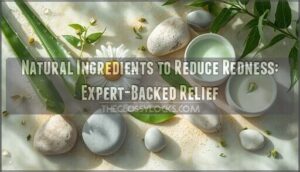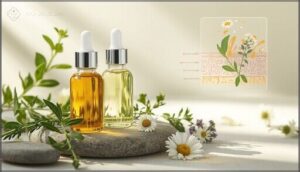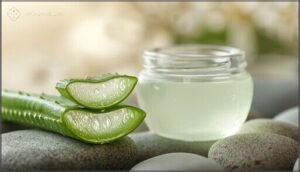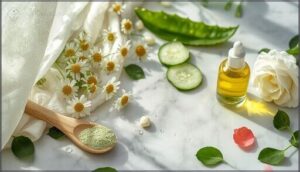This site is supported by our readers. We may earn a commission, at no cost to you, if you purchase through links.
Your face feels hot. You glance in the mirror and see patches of red spreading across your cheeks and nose. You’re not embarrassed or overheated—your skin just does this. Whether it’s triggered by a harsh winter wind, that glass of wine at dinner, or a new moisturizer you thought would help, redness can appear without warning and linger for hours or days.
The conventional approach often means reaching for heavy creams loaded with ingredients you can’t pronounce, but there’s another path. Natural compounds like aloe vera, chamomile, and green tea extract work with your skin’s biology to calm inflammation, strengthen your protective barrier, and reduce the visible flush that makes you self-conscious.
Table Of Contents
Key Takeaways
- Skin redness stems from dilated blood vessels and inflammation triggered by environmental factors, dietary choices, product ingredients, and conditions like rosacea or eczema—with pollution increasing inflammatory skin conditions by up to 121%.
- Natural compounds like aloe vera, chamomile, and green tea work through three pathways: blocking inflammatory molecules at the cellular level, rebuilding the skin’s protective barrier, and providing antioxidant defense against free radical damage.
- Supporting ingredients like ceramides, squalene, and jojoba oil strengthen the skin barrier from within—with topical ceramide products improving hydration by up to 55% after four weeks and addressing the root cause of persistent redness.
- Consistent application for four to eight weeks is necessary to see results, and you should apply natural ingredients within five minutes after cleansing while layering lightweight serums before barrier-strengthening moisturizers for maximum effectiveness.
What Causes Skin Redness?
Skin redness happens when blood vessels near the surface dilate or when inflammation sets in. The triggers span everything from environmental factors to underlying skin conditions.
Let’s break down what’s actually causing that flush or irritation you’re dealing with.
Common Triggers of Redness
While many factors can spark red skin, understanding the main culprits helps you take control. Environmental factors like extreme temperatures increase rosacea cases by 29.5%, and pollutants raise inflammatory skin conditions by up to 121%. Dietary triggers—spicy foods, alcohol, and hot coffee—commonly provoke flushing. Product ingredients such as fragrances and astringent alcohol irritate 82% of rosacea patients.
Lifestyle habits, allergic reactions, and sun exposure also contribute to skin redness. Certain skin conditions cause redness, such as eczema and rosacea.
Role of Inflammation in Red Skin
Inflammation is the main driver behind your red skin. When acute inflammation strikes, blood vessels dilate and flood your skin with warmth and visible redness—those classic signs doctors call rubor and calor.
Inflammation drives red skin by dilating blood vessels, flooding tissue with warmth and visible redness doctors call rubor and calor
Here’s what’s happening beneath the surface:
- Inflammatory mediators like IL-8 and TNF-α trigger visible redness with correlation coefficients reaching 0.85
- Vascular responses increase blood flow, creating that telltale flush
- Chronic inflammation builds persistent redness through ongoing vessel development
- Pro-inflammatory imbalance shifts healthy skin toward pathological redness patterns
- Clinical observations show antiinflammatory properties effectively target these mechanisms for reducing skin redness
As we age, this can be exacerbated by a process called inflammaging.
Skin Conditions Linked to Redness
While inflammation fuels redness, specific skin conditions turn it chronic. Rosacea, affecting 5% globally, shows up as persistent facial redness with flushing and visible blood vessels. Eczema impacts 10-20% of children and 2-10% of adults worldwide, characterized by itchy red patches. Psoriasis creates thick red plaques in 125 million people. Contact dermatitis and urticaria also trigger inflammatory red skin reactions.
How Natural Ingredients Calm Redness
Natural ingredients work through three main pathways to calm red skin. They target the underlying inflammation that causes visible redness, strengthen your skin’s protective barrier, and shield cells from further damage.
Understanding how these mechanisms function helps you choose the right ingredients for your specific concerns.
Anti-Inflammatory Actions Explained
When skin turns red, your body’s inflammation molecular pathways kick into high gear. Natural soothing ingredients work by targeting skin inflammation at its root:
- Chamomile and green tea block prostaglandin production, directly lowering redness biochemical markers
- Licorice root extract inhibits cyclooxygenase activity, reducing inflammatory mediators
- Feverfew disrupts cytokine signaling through specific anti-inflammatory actions
These ingredient efficacy data points explain why natural advantages trends continue gaining momentum.
Barrier Repair and Skin Soothing
Beyond reducing inflammation, soothing ingredients actively rebuild your skin’s protective layer. Topical sunflower oil accelerates barrier repair by 31% within an hour after damage. Chamomile’s apigenin triggers keratinocyte differentiation, while humectant benefits from glycerin and panthenol lock in skin hydration.
Studies show upregulating filaggrin through botanical extracts greatly improves TEWL reduction. Even NPS application demonstrates measurable barrier strengthening, giving your skin resilience against future irritation.
Antioxidant Protection for Irritated Skin
When free radicals attack your irritated skin, antioxidants like EGCG and resveratrol step in as your first line of defense. These soothing ingredients deliver powerful antiinflammatory effects by reducing oxidative stress and restoring barrier function.
Clinical efficacy data shows that topical antioxidants prevent inflammatory cytokine surges by up to 52%, giving you real inflammation control where skin irritation begins.
Top Natural Ingredients for Redness Relief
When you’re dealing with persistent redness, certain natural ingredients have earned their place in skincare through both traditional use and modern research. These botanicals work by targeting inflammation, supporting your skin’s protective barrier, and calming the visible signs of irritation.
Let’s look at six proven options that can help bring relief to reactive or flushed skin.
Aloe Vera Benefits
Aloe vera stands out as a powerhouse for UV redness relief and burn recovery. Studies show that 97.5% aloe vera gel noticeably reduces skin redness from sun exposure while offering hydrating properties without greasy residue—making it ideal for sensitive skin use.
You’ll notice relief within 1-2 days when applied multiple times daily. It even outperformed hydrocortisone as an alternative after 48 hours, thanks to its anti-inflammatory and soothing properties against skin irritation.
Calendula for Healing
Calendula extract offers considerable wound healing and skin regeneration benefits backed by clinical evidence. In trials involving 254 breast cancer patients, twice-daily Calendula officinalis ointment markedly reduced radiation dermatitis (P < 0.001).
You’ll see substantial improvement in skin redness within weeks—venous leg ulcers showed a 42% surface area reduction compared to 15% with standard treatment.
Its anti-inflammatory properties promote granulation and scar reduction while delivering soothing relief.
Chamomile’s Calming Effects
Chamomile brings anti-inflammatory properties that work at both cellular and surface levels to calm skin redness. Its active compound, apigenin, acts like a shield against inflammation while soothing skin irritation.
You’ll benefit most from chamomile when dealing with:
- Eczema Relief – reduces patches and discomfort in up to 20% of children and 3% of adults
- Wound Healing – accelerates collagen formation and recovery time
- Anti-Aging and sensitive skin care – minimizes irritation across skin types
Green Tea Extract
Green Tea extract acts as both an antioxidant and anti-inflammatory powerhouse for irritated skin. Studies show its compounds improve mild allergic contact dermatitis and rosacea symptoms within days.
You can apply it twice daily after a fifteen-minute soak for best results. Research confirms EGCG benefits include reduced erythema and edema with zero toxicity across all tested subjects, making product formulations exceptionally safe.
Licorice Root Extract
Licorice Root Extract offers powerful anti-inflammatory properties for soothing red skin. Its active compound, glycyrrhizin, reduces UV-induced irritation and post-shave redness while providing skin brightening benefits.
In rosacea treatment trials, daily application improved facial erythema considerably after eight weeks. This natural remedy demonstrates high tolerability for sensitive skin, making it an effective option for calming skin redness without adverse reactions across dermatological studies.
Cucumber for Cooling and Hydration
Cucumber brings soothing hydration through its high water content and anti-inflammatory compounds. You can apply fresh cucumber slices directly to red areas or use cucumber-infused products for cooling relief.
The vegetable’s natural enzymes reduce swelling while delivering moisture to irritated skin. Try blending cucumber into DIY masks with aloe or yogurt for enhanced calming properties that visibly decrease redness within minutes.
Supporting Ingredients for Skin Barrier Health
While anti-inflammatory ingredients work to calm visible redness, your skin also needs reinforcement from the inside out.
A compromised skin barrier often makes redness worse and harder to treat. The following ingredients don’t just soothe inflammation—they actually strengthen your skin’s protective layer to prevent future flare-ups.
Ceramides for Moisture Retention
Your skin’s moisture barrier relies on ceramides—lipid molecules that lock in hydration and prevent water loss. Aging reduces ceramide levels by over 30%, leading to increased TEWL and dryness.
In conditions like atopic dermatitis, ceramide deficiency can drop by 52%, worsening skin inflammation.
Topical ceramide products boost skin hydration considerably, with studies showing up to 55% improvement after four weeks of use.
Squalene for Inflammation Control
Squalene stands out for its ability to suppress skin inflammation at the cellular level. When applied topically, it boosts SOD expression—the enzyme your skin uses to fight oxidative damage—while downregulating TNF-α, a major inflammatory signal.
It also modulates macrophage response and limits neutrophil migration to inflamed areas, reducing tissue damage. These mechanisms help calm irritated skin and promote tissue remodelling for lasting redness relief.
Jojoba Oil for Balancing Skin
Jojoba Oil mimics your natural sebum, sending signals that cut oil production by 25% while hydrating dry patches. This dual action makes it ideal for balancing unstable skin prone to redness.
Its anti-inflammatory properties deliver measurable inflammation reduction—clinical outcomes show 30% drops in pro-inflammatory markers. Combine that with barrier enhancement, collagen support, and soothing properties, and you get:
- Enhanced moisture retention
- Reduced transepidermal water loss
- Accelerated wound healing
- Zero comedogenic risk
Vitamin C for Repair
Vitamin C‘s antioxidant properties accelerate collagen synthesis while delivering erythema reduction. Clinical outcomes show 9-11% wrinkle improvement and 52% less UVB-induced redness.
For rosacea and skin inflammation treatment, 5% L-ascorbic acid provides barrier restoration through enhanced ceramide production. You’re reducing skin redness while defending against photodamage.
Apply twice daily for 12 weeks to get the most from repair and resilience.
Tips for Using Natural Ingredients Safely
Natural ingredients can offer powerful relief for redness, but using them the right way makes all the difference. You’ll get the best results when you integrate them thoughtfully into your skincare routine and know when it’s time to call in professional help.
Here’s how to use these ingredients safely and effectively.
Incorporating Into Your Skincare Routine
Building an effective routine starts with timing and order. Apply natural ingredients within five minutes after cleansing to lock in hydration and boost their anti-inflammatory and soothing properties. Product layering matters—use lightweight serums with chamomile or green tea first, then follow with barrier-strengthening moisturizers containing ceramides or squalane.
To see real improvement, consistency beats intensity:
- Apply twice daily for antioxidant and skin barrier support
- Use weekly masks with botanical extracts for deeper calming
- Combine humectants and emollients to amplify ingredient synergy
Application methods should respect your skin’s tolerance while maintaining frequency guidelines that deliver results.
When to Seek Professional Advice
Even if your favorite natural ingredients feel safe, certain warning signs should never be ignored. Seek immediate care if you develop redness paired with fever or painful blisters—these acute symptoms signal possible infection in roughly 23% and 80% of cases respectively.
Persistent redness lasting over three days or recurring flare-ups point to rosacea or chronic skin conditions affecting millions. When concurrent conditions like swelling or oozing appear, or treatment failure persists despite consistent home care, seeing a doctor becomes essential.
Your demographic risks and skin sensitivity matter—dermatologist evaluation protects against complications.
Frequently Asked Questions (FAQs)
Can natural ingredients help with rosacea flare-ups?
Nature often provides the antidote near the ailment. Certain botanicals can help manage rosacea flare-up triggers effectively.
Ingredients like feverfew, aloe vera, and chamomile possess antiinflammatory soothing properties that calm redness and support long-term skin barrier health.
How long before natural remedies show results?
Most natural remedies require four to eight weeks of consistent application before you’ll see measurable results. Individual response varies based on your skin’s severity and the specific product combinations you choose.
Are natural ingredients safe for sensitive skin?
Ironically, “natural” doesn’t always mean safe. Over 90% of natural skincare products contain allergens linked to sensitive skin irritation.
Patch testing and careful ingredient selection remain essential for managing risk, despite the soothing properties many botanicals offer.
Can diet changes reduce facial redness naturally?
Yes. Reconsidering diet helps manage rosacea and redness triggers. Avoiding spicy foods, alcohol, and inflammatory foods while adding probiotic benefits through the gut-skin axis reduces flare-ups.
Food sensitivity matters when exploring home remedies for facial flushing.
Do natural ingredients work for all skin types?
Here’s the harsh truth: while plant-based remedies show impressive anti-inflammatory and soothing properties, skin type variability means some natural ingredients like aloe vera trigger allergic reaction risks.
Barrier function differences determine efficacy variations, making safe usage practices essential for sensitivity-prone skin.
Conclusion
You don’t need a pharmacy’s worth of synthetics to tame your skin’s fire. The right natural ingredients to reduce redness work at the cellular level to dismantle inflammation, fortify your barrier, and restore the calm complexion you’ve been chasing.
Start with one proven compound—aloe, chamomile, or green tea—and give it three weeks. Your mirror will reflect the difference.
Sometimes the most powerful remedy grows from the ground, not a lab.













